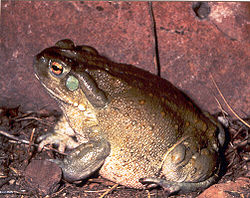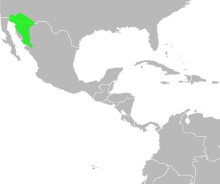Colorado River toad
| Colorado River toad | |
|---|---|
 |
|
| Scientific classification | |
| Kingdom: | Animalia |
| Phylum: | Chordata |
| Class: | Amphibia |
| Order: | Anura |
| Family: | Bufonidae |
| Genus: | Incilius |
| Species: | I. alvarius |
| Binomial name | |
|
Incilius alvarius Girard in Baird, 1859 |
|
 |
|
| Synonyms | |
|
Ollotis alvaria (Frost, 2006) |
|
Ollotis alvaria (Frost, 2006)
Bufo alvarius (Girard, 1859)
The Colorado River toad (Incilius alvarius), also known as the Sonoran Desert toad, is a psychoactive toad found in northern Mexico and the southwestern United States. Its toxin, as an exudate of glands within the skin, contains 5-MeO-DMT and bufotenin.
The Colorado River toad can grow to about 190 millimetres (7.5 in) long and is the largest toad in the United States apart from the non-native cane toad (Rhinella marina). It has a smooth, leathery skin and is olive green or mottled brown in color. Just behind the large golden eye with horizontal pupil is a bulging kidney-shaped parotoid gland. Below this is a large circular pale green area which is the tympanum or ear drum. By the corner of the mouth there is a white wart and there are white glands on the legs. All these glands produce toxic secretions.
Dogs that have attacked toads have been paralyzed or even killed. Raccoons have learned to pull a toad away from a pond by the back leg, turn it on its back and start feeding on its belly, a strategy that keeps the raccoon well away from the poison glands. Unlike other vertebrates, this amphibian obtains water mostly by osmotic absorption across their abdomen. Toads in the family bufonidae have a region of skin known as "the seat patch", which extends from mid abdomen to the hind legs and is specialized for rapid rehydration. Most of the rehydration is done through absorption of water from small pools or wet objects.
The Colorado River toad is found in the lower Colorado River and the Gila River catchment areas, in southeastern California, New Mexico, Mexico and much of southern Arizona. It lives in both desert and semiarid areas throughout its range. It is semiaquatic and is often found in streams, near springs, in canals and drainage ditches, and under water troughs. The Bufo alvarius is known to breed in artificial water bodies (e.g., flood control impoundments, reservoirs) and as a result, the distributions and breeding habitats of these species may have been recently altered in south central Arizona. It often makes its home in rodent burrows and is nocturnal. Its call is described as, "a weak, low-pitched toot, lasting less than a second."
...
Wikipedia

